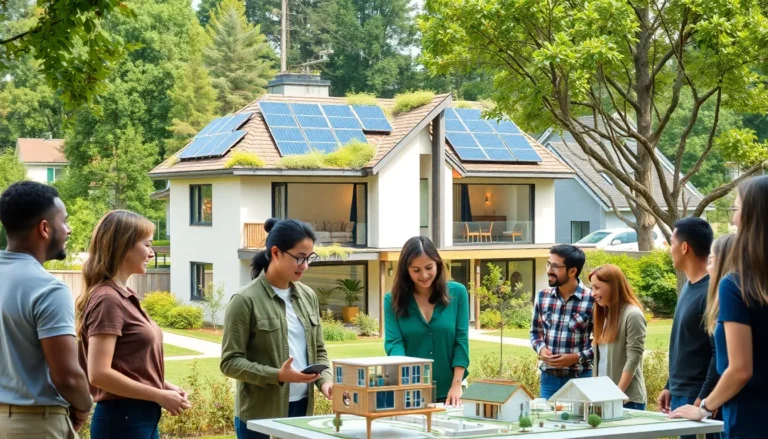Table of Contents
ToggleIn the fast-paced world of real estate, staying ahead of the curve isn’t just a goal—it’s a necessity. As buyers and sellers increasingly turn to the internet for their property needs, understanding the latest website trends can make all the difference. Imagine a website so captivating that it makes potential clients feel like they’re scrolling through a virtual open house while sipping their morning coffee. Sounds dreamy, right?
Overview of Real Estate Website Trends
Current real estate websites continually adapt to meet user expectations. Enhanced user experiences play a crucial role, as potential buyers and sellers now demand streamlined navigation and quick access to information. Mobile responsiveness remains essential, ensuring websites function seamlessly on smartphones and tablets.
Visual content captivates visitors. High-quality images and videos of properties create immersive experiences, simulating physical walkthroughs and engaging clients. Utilizing virtual tours has gained traction, allowing users to explore spaces remotely. Interactive features enrich user engagement, enhancing property search efficiency.
Moreover, personalization fosters stronger connections with potential clients. Tailored content and recommendations based on user behavior lead to higher engagement rates. Integrating chatbots facilitates instant communication, addressing inquiries and guiding users through processes, thus improving satisfaction.
SEO strategies continue evolving. Incorporating local keywords boosts search visibility, making properties easier to find in specific geographic areas. Content marketing, including informative blogs and market analysis, establishes authority and attracts visitors.
Innovative technologies, such as artificial intelligence, streamline operations. AI tools analyze user preferences, enhancing property matching and providing data-driven insights. Integrating these technologies optimizes both user experience and operational efficiency.
Trends also reflect a growing emphasis on sustainability. Eco-friendly features attract environmentally conscious buyers, leading to increased property values. Websites showcasing green initiatives resonate with this demographic, highlighting energy-efficient homes and sustainable practices.
Keeping pace with these trends establishes a competitive edge in the real estate market. Focusing on user experience, personalization, and advanced technologies creates engaging platforms that meet the needs of today’s buyers and sellers efficiently.
Emerging Technologies in Real Estate Websites

Emerging technologies play a significant role in the evolution of real estate websites. They provide innovative solutions that enhance user engagement and streamline property transactions.
Virtual Tours and 3D Listings
Virtual tours and 3D listings deliver immersive property experiences online. Users can navigate spaces at their own pace, which increases engagement and interest. This technology enables potential buyers to visualize themselves in a property without physically visiting the site. Furthermore, showcasing properties through interactive listings allows real estate agents to stand out in a competitive market. An emphasis on high-quality visuals in these tours enhances the overall appeal, making homes more attractive to buyers.
Artificial Intelligence Features
Artificial intelligence features significantly improve user experience on real estate websites. AI algorithms analyze user behavior and preferences to deliver personalized property recommendations. This level of customization fosters stronger connections between agents and clients. Chatbots, powered by AI, offer instant assistance, answering queries and providing information around the clock. By streamlining communication, these features increase user satisfaction and increase the likelihood of successful transactions. Overall, AI transforms property searches into more efficient and user-friendly processes.
User Experience and Design Trends
Real estate websites must cater to evolving user expectations. Prioritizing user experience with intuitive design significantly impacts engagement.
Mobile Responsiveness
Mobile devices account for over 50% of web traffic. Consequently, real estate websites must offer seamless browsing experiences on smartphones and tablets. Websites optimized for various screen sizes ensure users access listings without unnecessary zooming or scrolling. Fast-loading pages enhance user satisfaction and retention, lowering bounce rates. Utilizing responsive design improves accessibility, allowing potential buyers to explore properties anytime, anywhere.
Simplified Navigation
Effective navigation simplifies the search for properties. Clearly labeled categories and efficient search functions lead users directly to what they seek. Users appreciate filter options, enabling them to narrow down choices by criteria like price, location, and amenities. Incorporating breadcrumbs helps visitors understand their location within the site, enhancing overall usability. Engaging layouts enhance visual hierarchy and make essential information readily available, creating an intuitive browsing experience.
Content Strategy and Marketing Trends
Content strategy increasingly shapes real estate websites. Focused on audience engagement, effective strategies leverage localized content and video marketing to enhance customer connections.
Localized Content
Real estate professionals emphasize the importance of creating localized content. Integrating region-specific information boosts search visibility and relevance. For instance, articles highlighting neighborhood amenities, local schools, and market trends attract potential buyers. Search engines favor websites with consistent local keywords in their content. Personalization enhances user engagement, making visitors feel more connected to specific communities. Moreover, testimonials and success stories from local clients build trust and credibility. Providing localized insights fosters a deeper understanding of the market, driving increased traffic to listings.
Video Marketing Integration
Video marketing integration proves essential for real estate websites. High-quality videos showcasing properties capture attention more effectively than images alone. Interactive virtual tours serve as engaging tools, allowing users to explore homes from anywhere. Additionally, live-streamed open houses expand the reach of property viewings, drawing in potential buyers who may be unable to attend in person. Incorporating educational videos about the buying and selling process further establishes expertise and promotes trust. Utilizing video content increases shareability, helping listings gain visibility across social media channels. Consistent video marketing fosters lasting relationships with clients, encouraging repeat business and referrals.
Sustainability and Eco-Friendly Features
Sustainability plays a crucial role in modern real estate websites, reflecting a growing awareness of environmental issues. Eco-friendly features attract environmentally conscious buyers and contribute to increasing property values. Incorporating green building certifications, energy-efficient appliances, and sustainable materials showcases commitment to eco-friendliness.
Websites increasingly highlight solar panels, energy-efficient windows, and smart home technologies in listings. These features appeal to buyers interested in reducing their carbon footprint. Developers highlight sustainable urban designs that prioritize green spaces and enhance community well-being.
Listings now often include information about local sustainability initiatives, such as recycling programs and green certifications for neighborhoods. Filtering options allow users to specifically search for eco-friendly properties, making it easier for buyers to find homes that align with their values. Sustainability ratings and eco-friendly scorecards present concise snapshots of a property’s environmental impact, aiding decision-making.
The integration of interactive elements further enhances user engagement. Virtual tours showcase eco-friendly features in real-time, allowing potential buyers to visualize their living situations within sustainable environments. Additionally, educational content related to eco-friendly living and energy-saving tips provides ongoing value to visitors.
Real estate professionals leverage social media platforms to promote the sustainable aspects of their listings. Engaging posts and videos emphasize the benefits of eco-friendly features, driving interest among potential buyers. As sustainability continues to gain momentum, real estate websites adapt and innovate, ensuring they meet the expectations of today’s environmentally conscious consumers. By prioritizing these elements, agents position themselves as leaders in a market increasingly focused on sustainability.
Staying ahead in the real estate industry requires embracing the latest website trends. A well-designed website not only attracts potential clients but also enhances their experience through intuitive navigation and engaging content.
As technology evolves so do user expectations. Real estate professionals must prioritize mobile responsiveness and fast-loading pages to cater to the growing number of mobile users.
Incorporating visual elements like high-quality images and virtual tours can significantly improve user engagement. Additionally focusing on sustainability and personalization will resonate with today’s environmentally conscious buyers.
By adopting these strategies real estate websites can effectively meet the demands of modern consumers and stand out in a competitive market.




